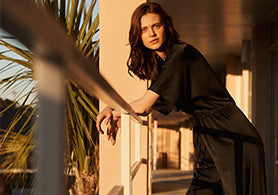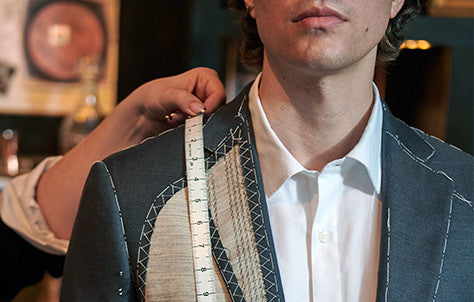With his 2015 solo show at Alternative Gallery, entitled “Souvenir,” Fletcher Williams III established himself as a leading figure in Charleston’s contemporary art scene. His multimedia work has touched upon themes both cultural and political but defies pigeonholing, as he seeks to examine “these strange gateways and labyrinths of the South.” We visited his Charleston studio to learn more.
SHOP BY
Explore the Icons
SHOP BY

Explore Our Newest Arrivals
In The Studio With | Fletcher Williams III
Fletcher, in his downtown Charleston studio, creates a base pattern for a new “moss-scape” using Spanish moss and acrylic paint.
What was your path to becoming an artist?
I'm a Charleston native and attended the Charleston County School of the Arts, so I've been studying art my entire life. In 2007, I was accepted to The Cooper Union in New York, so that's kind of where things got really serious. It's funny, before I left I had this fundraiser exhibition in a hair salon on East Bay Street, called Opus. It was a pretty good turnout but all that money I made I blew within a week in New York. So I was back to square one [laughs].
Cooper is a very interdisciplinary, very experimental program. I studied everything from film, photography, printmaking, sculpture, painting… Coming from South Carolina, where everything is very traditional and conventional, it was a free for all, which is pretty cool. And it really deconstructed my thinking around what it was to be an artist and how to make work.
Spanish moss stamped and dragged to emulate the movement and pattern of moss. Fletcher then adds motifs using stencils and an airbrush.
So why come back to Charleston?
Much of the work I was doing at The Cooper Union had everything to do with living in the South, and I was incorporating everything from LED corner store lights to rap lyrics into my work. So, in 2013 I decided to return to Charleston, where I came across another uniquely southern craft. I worked at a hotel, shuttling people to and from the marina to Market Street. That's where I met the kids who make palmetto roses. I was interested in their entrepreneurship, wandering the streets, hustling roses, and I saw the beauty and intricacy of their tightly hand-woven roses. I wanted to celebrate the rosemakers and use palmetto roses to describe the South's cultural landscape. In 2015, I had my first solo exhibition on Spring Street, and this was the first demonstration, at least for everyone in Charleston, that I took my career very seriously.
What was the response?
I had ambitious work there; I created a tree sculpture with roughly 3000 palmetto roses. With that exhibition, I aligned myself with the history and culture of Charleston. I realized there was a natural appetite for this work that was missing from the local art scene. I garnered a lot of attention, started to get demand for my work, and moved forward from there. I've worked independently as an artist since that exhibition.
You mentioned that you’ve always worked within this Southern, Charleston vernacular. Why is that important to you?
I felt the need to tell a familiar story and express myself through that vernacular, through those aesthetics, and bring to the table a conversation about contemporary Black culture in Charleston. Everything is so traditional and steeped in history—which is great. That's certainly part of the narrative, but a lot was missing, the contemporary South that my friends, peers, and constituents would enjoy experiencing through art.
Gathering moss at Hampton Park. “I prefer this moss because it acts very similar to a paintbrush,” explains Fletcher, “but because it's essentially a loose ball of threads I can create delicate charcoal-like marks or dark dense marks on the paper.”
“What I like about using different materials is that the process leads to unexpected results. So I can paint with a brush or I can paint with moss.”
How do you see your role within the artistic community?
I'm one of few Black contemporary artists here. My work has been well received, and I'm being commissioned by arts organizations and private collectors locally and abroad. I was recently commissioned by Spoleto Festival USA to design their new chamber music backdrop at the Dock [Street Theatre]. These partnerships have made my presence here much larger. I'm conscious of my big fish-little pond position, ensuring I do it responsibly and keep busting down these old walls for other emerging artists since I hold this seat.
Can you tell us about what you’re working on now?
What I like about using different materials is that the process leads to unexpected results. So I can paint with a brush or I can paint with moss. So lately [it's been] these paintings where I'm using moss with acrylic paint. I view these paintings as backdrops for the new steel sculpture I'm experimenting with. I've been making picket fence trellises beginning as plywood prototypes that will ultimately live outside as steel sculptures. I'm up to that now, and it's very experimental. A lot of abstraction, a lot of surrealism. And that's an exciting way to describe the South, as this whimsical mythical place, these strange gateways. I want to see it in a new way, requiring that I strip back the layers and get to the core of this place, the South.
If someone wanted to see Charleston’s art scene through your eyes, where should they go?
For someone coming to Charleston and wanting to step off Museum Mile, you might have to venture into North Charleston a bit or go out to Johns Island. I think the Halsey [Institute of Contemporary Art] does a good job; there's Redux Contemporary Art Center. Spoleto Festival... people get excited about that. [Director] Mena Mark Hanna brings great energy and a willingness to shake things up.
Fletcher photographed at Hampton Park. “Like most of Charleston, Hampton Park is hallowed ground,” he says.



